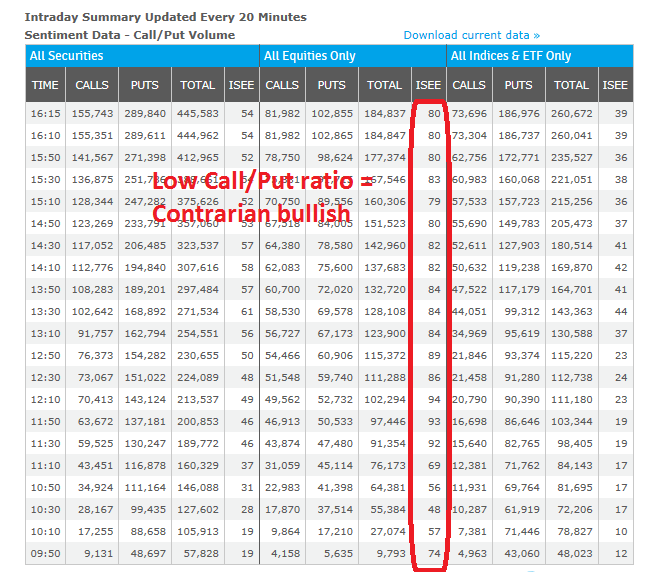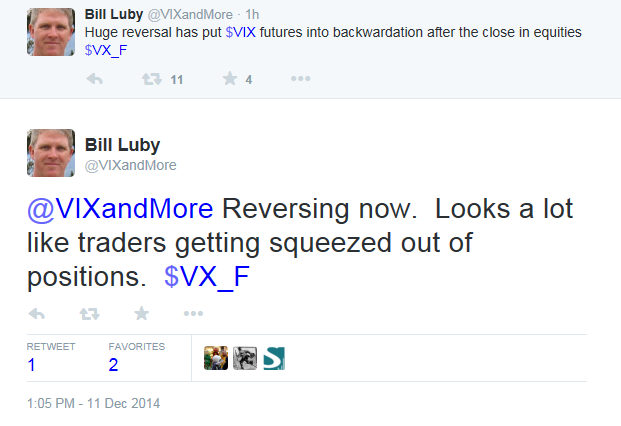OK, I was a day early in my bottom call (see Why today (Dec 9) was like the October bottom), but my short-term trading models continue to indicate that we are seeing a short-term bottom in the SPX.
Option market flashes buy signals
First, option traders are getting frightened, which is contrarian bullish. The ISEE equity-only call-put ratio were very low all day, on Thursday December 11. Readings under 100% often indicate a crowded short.

As well, Bill Luby, who blogs at VIX and More, observed in a tweet that the VIX term structure had briefly inverted just before the market close. VIX term structure inversion is an indication of extreme fear in the market.

Inside Day reversal signal
From a technical standpoint, the SPX chart below also flashed a couple of tactically bullish signals. First, the 5-day RSI, which is useful for swing trading short-term moves, moved off an oversold level of below 30. Such events often signal upside for the index.

In addition, the SPX also experienced an "inside day" yesterday (Thursday, December 11, 2014) after hitting the lower Bollinger® Band on Wednesday. An "inside day" occurs when the daily range of a stock or index is inside the previous day's daily high-low range. According to Jamie Saettele at Investopedia, the appearance of an inside day while the price touches either the upper or lower Bollinger Band can be an indication of reversal.
The Bollinger Band defines the overbought or oversold reading, while the inside day signals indecision or trend exhaustion (emphasis added):
Prices at the upper Bollinger Band® are considered high and prices at the lower Bollinger Band® are considered low. However, just because prices have hit the upper Bollinger does not necessarily mean that it is a good time to sell. Strong trends will 'ride' these bands and wipe out any trader attempting to buy the 'low' prices in a downtrend or sell the 'high' prices in an uptrend. Therefore, just buying at the lower band and selling at the upper band is out of the question. By definition, price makes new highs in an uptrend and new lows in a downtrend, which means that they will naturally be hitting the bands. With this information in mind, our filter will require that buy signals occur only if the candle following the one that hits the Bollinger Band® does not make a new high or low. This type of candle is commonly known as an inside day. The best time frames to look for the inside days are daily charts, but this strategy can also be used on hourly, weekly and monthly charts. Combining inside days with Bollinger Bands® increases the likelihood that we are only picking a top or bottom after prices have hit extreme levels. As a rule of thumb, the longer the time frame, the rarer the trade will be, but the signal will also be more significant. (For more insight, see Using Bollinger Band® "Bands" to Gauge Trends and Capture Profits With Bands And Channels.)
Candlesticks and their respective patterns illustrate the psychology of the market at a particular point in time. Specifically, the inside candle represents a period of contracted volatility. If, in an uptrend, volatility begins to slow and the market fails to make a new high (as illustrated by the inside candle), then we can deduce that strength is waning and that the chance for a reversal exists. When combined with a Bollinger Band®, we ensure that we are trading a reversal only by either selling high prices (higher Bollinger Band®) or buying low prices (lower Bollinger Band®). In this way, we trade for the big move; not necessarily selling the low tick or buying the bottom tick but definitely buying near the relative bottom and selling near the relative top. The key is confirmation.
Event risk next week
Should the stock market rally as I expect, I would nevertheless be wary of volatility stemming from major event risk next week. First, there is the Greek presidential election on December 17. Already, Greek bond yields and stock market are plunging over the political uncertainty.
As well, the FOMC is meeting December 16-17. There is a strong possibility that we may not only see the removal of the "considerable time" language from the statement. Not only that, we may see a far more hawkish tone from the Fed as the most recent speech from NY Fed Governor and Yellen circle insider William Dudley stated that a mid-2015 liftoff in interest rates is more or less baked-in:
Market expectations that lift-off will occur around mid-2015 seem reasonable to me. Although that could change depending on how the economy evolves, my views on “when” do not differ appreciably from the most recent primary dealer and buy-side surveys undertaken by the New York Fed prior to the October FOMC meeting.
Not only that, he warned the market against the expectation of a Yellen Put:
Let me be clear, there is no Fed equity market put. To put it another way, we do not care about the level of equity prices, or bond yields or credit spreads per se. Instead, we focus on how financial market conditions influence the transmission of monetary policy to the real economy. At times, a large decline in equity prices will not be problematic for achieving our goals. For example, economic conditions may warrant a tightening of financial market conditions. If this happens mainly via the channel of equity price weakness—that is not a problem, as it does not conflict with our objectives. In contrast, when we want financial market conditions to be extremely accommodative—as has been the case in recent years when we have been far away from our employment and inflation objectives—then we will take into consideration a broad set of developments with respect to interest rates, the stock market and other measures of financial conditions in choosing the appropriate stance for monetary policy.
Just be warned that traders who go long here should be here for a good time, but not a long time. On December 17, all bets are off.
Disclosure: Cam Hui is a portfolio manager at Qwest Investment Fund Management Ltd. ("Qwest"). This article is prepared by Mr. Hui as an outside business activity. As such, Qwest does not review or approve materials presented herein. The opinions and any recommendations expressed in this blog are those of the author and do not reflect the opinions or recommendations of Qwest.
None of the information or opinions expressed in this blog constitutes a solicitation for the purchase or sale of any security or other instrument. Nothing in this article constitutes investment advice and any recommendations that may be contained herein have not been based upon a consideration of the investment objectives, financial situation or particular needs of any specific recipient. Any purchase or sale activity in any securities or other instrument should be based upon your own analysis and conclusions. Past performance is not indicative of future results. Either Qwest or Mr. Hui may hold or control long or short positions in the securities or instruments mentioned.
